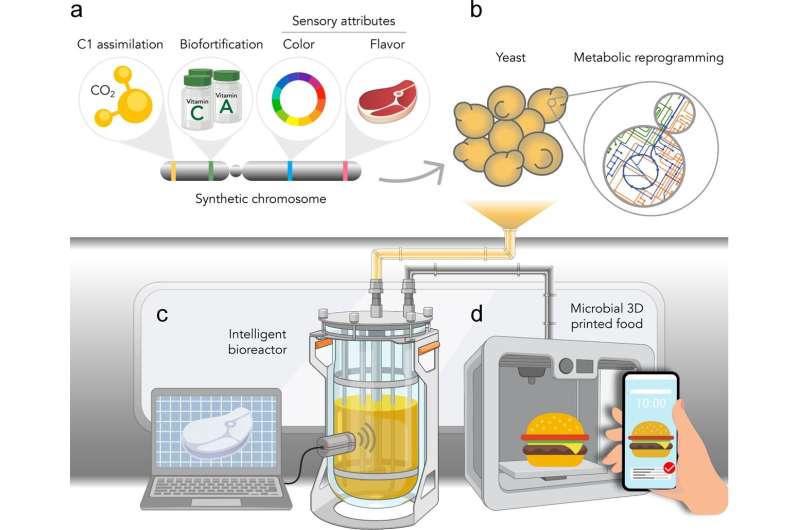The future of space food: Using bioengineered yeast to feed humans off-Earth

Take a common form of yeast, a 3D printer, and some clever science, and what do you have? A versatile and nutritious food system for tomorrow's discerning space traveler.
In a new Nature Communications paper, researchers from Macquarie University and the ARC Center of Excellence in Synthetic Biology outline a vision for a customizable food system that provides dishes with the taste, texture and nutrients of their Earth-bound counterparts.
The primary ingredient used in the space food system is the yeast Saccharomyces cerevisiae (S. cerevisiae), a food-grade microorganism with thousands of years of usage in baking, brewing and wine-making. Yeast cells are already nutritious, containing substantial protein, carbohydrates, small amounts of fat, and most essential amino acids that humans require from food. With some engineering, S. cerevisiae can be further bolstered to add nutrients, taste, color, and texture.
"The best approach for sustaining extended human space ventures is to produce food on-site," says lead author Dr. Briardo Llorente from the School of Natural Sciences at Macquarie University.
Previous work has estimated that all vitamins and macronutrients necessary for a balanced human diet could feed 50–100 people a day from one 3,000 liter fermentation tank, making S. cerevisiae a promising candidate for developing into a microbial food-production system.
Rather like Star Trek's replicator food system, which synthesized food on demand, this system would involve using the power of synthetic biology to bestow yeast with the capacity to produce the common nutrients and sensory attributes of Earth-made foods like flavors, colors, smells, and textures. This will make it possible to generate microbial-based food with desirable sensory and nutritional profiles.
The scientists believe that 3D-food printing technologies could be used to make custom meals for astronauts utilizing these modified yeast cells.
Imagine food, rather like sushi or lasagna, where each layer presents a different color, taste and texture. Or a compact protein-like bar that tastes and smells exactly like banana.
The innovative food system will also contribute to the circular economy, with the engineered foods leaving little to no waste for space travelers while maximizing food production capabilities off-Earth.
"Essentially, what we propose is developing technology and capabilities that will transform yeast from being the basic microbe we use to produce foods into something that is much more powerful that can actually be used as a complete food source," says Dr. Llorente. "With further research, we can use synthetic biology to consolidate multiple sensory and nutritional attributes and develop innovative food production systems that are sustainable and more environmentally friendly."
While space is the obvious use case, given the limitations of producing food in difficult environments, Dr. Llorente and the team believe engineered yeast has huge potential for addressing sustainability right here on Earth.
"As we see engineered food sources gain more popularity in the mainstream, there is a growing market for the increased use of engineered yeast in combatting sustainability issues. These alternative foods could one day solve some of our most complex problems relating to sustainably addressing food security while removing pressure from natural ecosystems," says Dr. Llorente.
More information: Briardo Llorente et al, Harnessing bioengineered microbes as a versatile platform for space nutrition, Nature Communications (2022). DOI: 10.1038/s41467-022-33974-7
Journal information: Nature Communications
Provided by Macquarie University



















